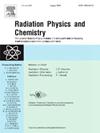Damage mechanisms caused by radiation in Proton(ion beam) double interface layer nano-MOS structure
IF 2.8
3区 物理与天体物理
Q3 CHEMISTRY, PHYSICAL
引用次数: 0
Abstract
In this study, the effects of ion beam (proton) on the PbO/SnO2/p-Si double interfacial layer MOS Schottky diode material were studied. The parameters of the ionizing radiation detection properties and radiation resistance of using double interfacial oxide layers were analyzed in MOS Schottky diodes. In the analysis, SRIM/TRIM software code was examined theoretically and modeled using simulation. The displacement per atom occurs more in the SnO2 oxide layer than in the other interface layer. This can be explained by the concept of Bragg Curve Peak, which occurs as a result of ion beam induced doping effect. It has been observed that the electrical properties of the PbO/SnO2/p-Si double interface layer MOS Schottky diode structure in terms of sensing ionizing radiation change after ion beam induced doping and the interface states are affected. It has been shown that our double interface layer nano-MOS structure can be used as a ion beam based sensor on these results. In addition to the inelastic collision, without causing ionization NIEL values of PbO and SnO2 layers were found to be 424.88 MeV. cm2/g and 524.9 MeV. cm2/g, respectively. These theoretical results were shown as graphs using the TRIM Monte Carlo simulation program and the behavior of the phonons in the layers was modeled. Additionally, LET values were calculated according to layers and compared with the simulation results of TRIM. While the LET value of the PbO layer was 889.3 MeV. cm2/g, the LET value of the SnO2 layer was determined to be 1639 MeV cm2/g. The LET concept is visually presented with the TRIM software and it is seen that the displacement per atom is highest in the SnO2 layer and the Bragg Curve reaches its maximum point. Thus, it can be seen that the SnO2 layer produces more transient damage and oxide interface traps compared to the PbO layer as ionizing radiation propagates between the oxide layers. By studying the effects of the ion beam source on the MOS Schottky diode structure, it is shown that the double interface layer structure increases the oxide interface traps and the SnO2 material is promising in terms of radiation sensing and detection properties. Moreover, MOS Schottky states that using a double interface layer instead of a single oxide layer in MOS structures positively increases the number of interface traps in the oxide layer for ion beam radiation detection.
质子(离子束)双界面层纳米 MOS 结构的辐射损伤机制
本研究探讨了离子束(质子)对 PbO/SnO2/p-Si 双界面层 MOS 肖特基二极管材料的影响。分析了 MOS 肖特基二极管中使用双界面氧化层的电离辐射检测性能和抗辐射性能参数。在分析过程中,对 SRIM/TRIM 软件代码进行了理论研究和模拟建模。与其他界面层相比,SnO2 氧化物层中每个原子的位移更大。这可以用布拉格曲线峰的概念来解释,它是离子束诱导掺杂效应的结果。据观察,在离子束诱导掺杂后,PbO/SnO2/p-Si 双界面层 MOS 肖特基二极管结构在感应电离辐射方面的电气特性发生了变化,界面态也受到了影响。这些结果表明,我们的双界面层纳米 MOS 结构可用作基于离子束的传感器。除了非弹性碰撞外,还发现 PbO 和 SnO2 层在不引起电离的情况下的 NIEL 值分别为 424.88 MeV.这些理论结果通过 TRIM 蒙特卡洛模拟程序以图表形式显示出来,并对各层中的声子行为进行了建模。此外,还计算了各层的 LET 值,并与 TRIM 的模拟结果进行了比较。氧化铅层的 LET 值为 889.3 MeV. cm2/g,而二氧化锡层的 LET 值则确定为 1639 MeV cm2/g。利用 TRIM 软件可直观地显示 LET 概念,可以看出二氧化锡层中每个原子的位移最大,布拉格曲线也达到最大点。由此可见,当电离辐射在氧化物层之间传播时,与氧化铅层相比,二氧化锡层会产生更多的瞬时损伤和氧化物界面陷阱。通过研究离子束源对 MOS 肖特基二极管结构的影响,可以看出双界面层结构增加了氧化物界面陷阱,SnO2 材料在辐射传感和检测性能方面很有前景。此外,MOS 肖特基指出,在 MOS 结构中使用双界面层而不是单氧化物层,可以积极增加氧化物层中的界面陷阱数量,从而实现离子束辐射探测。
本文章由计算机程序翻译,如有差异,请以英文原文为准。
求助全文
约1分钟内获得全文
求助全文
来源期刊

Radiation Physics and Chemistry
化学-核科学技术
CiteScore
5.60
自引率
17.20%
发文量
574
审稿时长
12 weeks
期刊介绍:
Radiation Physics and Chemistry is a multidisciplinary journal that provides a medium for publication of substantial and original papers, reviews, and short communications which focus on research and developments involving ionizing radiation in radiation physics, radiation chemistry and radiation processing.
The journal aims to publish papers with significance to an international audience, containing substantial novelty and scientific impact. The Editors reserve the rights to reject, with or without external review, papers that do not meet these criteria. This could include papers that are very similar to previous publications, only with changed target substrates, employed materials, analyzed sites and experimental methods, report results without presenting new insights and/or hypothesis testing, or do not focus on the radiation effects.
 求助内容:
求助内容: 应助结果提醒方式:
应助结果提醒方式:


